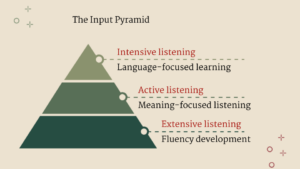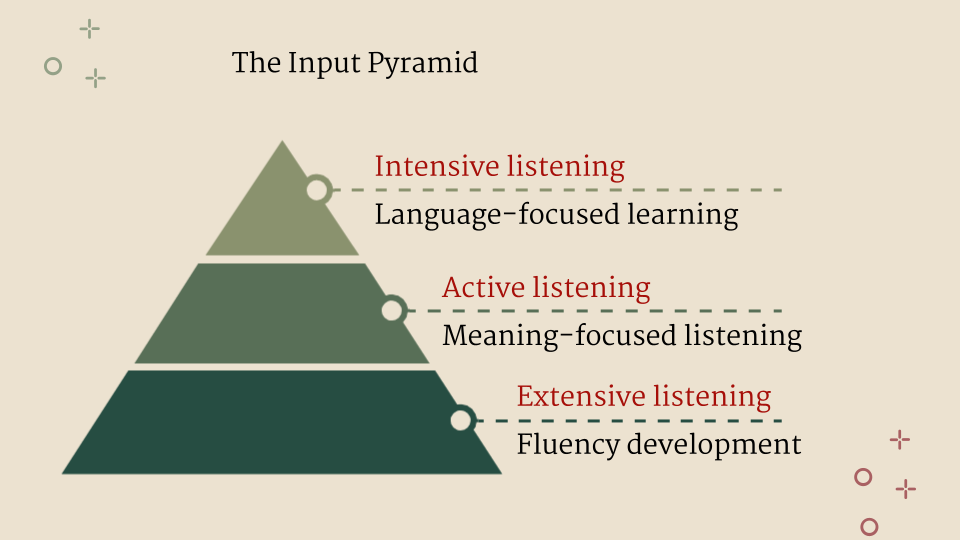 When improving listening comprehension in Mandarin, there are three factors you should try to improve:
When improving listening comprehension in Mandarin, there are three factors you should try to improve:
- Content: What you listen to
- Method: How you listen
- Time: How much you listen
If you want to make rapid progress, you need to maximise all three. This is more easily said than done.
This article is based on a lesson in my video course The Fluent Listener: Navigating Spoken Mandarin Like a Fish in Water.
You can watch the entire lesson for free on YouTube here: The Input Pyramid: Chinese Listening for Any Situation (Ep. 236)
You can also tune in to the Hacking Chinese Podcast to listen to the related episode (#235):
Available on Apple Podcasts, Spotify, YouTube and many other platforms!
Let’s have a look at the first part: content.
- What should you listen to?
- How difficult should it be?
- How much should you understand?
- How can you make sure you always have something suitable to listen to?
Listening more to the right kind of Chinese content
The question of difficulty is perhaps the most important one. Most students only listen to very challenging content, and as a result, get frustrated and don’t spend anywhere near as much time as they should. This is common in formal education; almost all courses focus exclusively on intensive listening.
How you approach listening can affect difficulty. Relistening is easier than listening to something new, and watching a slow-paced video with visual support is easier than listening to a written text read aloud quickly.
The Fluent Listener: Navigating Spoken Mandarin Like a Fish in Water
This course will help you become a fluent listener, no matter your proficiency level. It guides you in building an immersive listening environment and equips you with essential listening strategies.
Strengthen your listening to connect with others and navigate Chinese culture with ease, feeling 如鱼得水 (rúyúdéshuǐ) or “like a fish in water”.
You can read more about the course here: The Fluent Listener: Navigating Spoken Mandarin Like a Fish in Water
If you prefer to read about the Input Pyramid, the rest of this article is for you! It covers roughly the same content as the video above.
The Input Pyramid: Chinese Listening for Any Situation
To give you a simple framework for how to think about what you listen to, I present the Input Pyramid. It works for listening and reading, but we’ll focus on listening here. The goal is to show that you need input on different difficulty levels to get the most out of your practice.
The base of the pyramid consists of extensive listening at a comfortable difficulty level suitable for fluency development. In contrast, the top of the pyramid consists of intensive listening at the limit of what you can handle.
The pyramid shape shows that you should spend most of your time with relatively easy listening materials, and only tackle harder content when you want to or have to. The slices are not to scale, however, so in practice, the base should be much broader than the graphic representation shows.
Let’s have a look at each slice of the pyramid, starting from the base.
1. Extensive listening (base of the pyramid)
Extensive listening is when you can understand most of what you listen to and, as a result, can focus on the meaning, as opposed to the language. If you listen to a podcast and find the topic interesting, enjoy listening to the conversation and feel that you want to know more, this is probably extensive listening.
This is a type of fluency development, meaning that the content you listen to can’t contain too many unknown words or grammar patterns, because then the focus will inevitably be on the language, not the message the language is being used to convey. Fluency development is one of Paul Nation’s four strands.
Intermediate and advanced learners might feel that the content is too easy, but as long as you find it interesting and engaging, this is not the case. Every word and phrase you hear helps you speed up the listening process, reviews vocabulary you have learnt and makes subsequent listening easier.
Beyond tīng bu dǒng, part 4: Learning to process spoken Mandarin quickly and effortlessly
Do not make the mistake of thinking that just because something doesn’t contain many new words, it’s not worth listening to.
Beginners will struggle to find content that qualifies as extensive listening, simply because everything will be new. One simple trick to get around this problem is to listen to the same content more than once. You can also try listening to very similar content from different sources, such as two podcasts about the same topic, or a chapter about going to the airport in two different textbooks.
As a beginner, you will build the pyramid from top to bottom, but all learners should try to build a solid base. Learn more about beginner listening here: Beginner Chinese listening practice: What to listen to and how.
Beginner Chinese listening practice: What to listen to and how
2. Engaged listening (middle of the pyramid)
Extensive reading and listening are well-established concepts in the world of language acquisition. Engaged listening, which makes up the middle slice of the pyramid, is a term I’ve come up with to describe a kind of listening that requires more effort than extensive listening but is still accessible without extra tools and resources.
Just like extensive listening, engaged listening is meaning-focused. This means that when listening, you are mostly able to focus on what people say, not the vocabulary and grammar patterns they use to say it.
This still requires you to know most of the language in advance, otherwise the emphasis will automatically be on the language you don’t know. Meaning-focused input is another strand in Paul Nation’s model.
The difference between engaged listening and extensive listening is that engaged listening requires you to be, well, engaged. The content is comprehensible, but only if you focus fully on it.
Extensive listening can be relaxing, but engaged listening usually isn’t. You might need to listen more than once or think a bit before you realise what something means.
Listen more than once: How the replay button can help you learn more Chinese
3. Intensive listening (top of the pyramid)
Intensive listening is what most students do most of the time. If listening feels like trying to crack a difficult code and you need extra scaffolding, such as transcripts and dictionaries, to succeed, then you’re probably doing intensive listening. Listening to the next chapter in your textbook or a podcast a bit beyond your current capabilities are good example of intensive listening.
Because of the higher difficulty level, intensive listening is not primarily meaning-focused. The new words and expressions require time and effort to deal with, and before you’ve cracked the code, understanding will be elusive. This is language-focused learning, which is also one of Paul Nation’s four strands.
When to listen to what kind of content in Chinese
As mentioned, the idea behind the pyramid is to show that all these types of listening are necessary, but that you need to pay attention to the proportions.
Most students only listen intensively. This means that you will spend a lot of time on short passages because it takes time to look things up or listen enough times that you understand.
Understand more: Build sound-meaning connections
Alternatively, if you only listen once, it means that you don’t understand enough to learn effectively from the Chinese you listen to. This violates one of the key principles of successful listening practice, namely that you should understand as much as possible so that you can make sound-meaning connections.
Four key principles to improve your Mandarin listening comprehension
When you understand more, you build the neural pathways in your brain that allow you to deal with vocabulary and grammar in diverse contexts.
To truly become a fluent listener, you need to be able to understand words not just in the specific sentences you’ve studied them in, which is common if you focus on intensive listening, but also in completely new sentences. The only way to do that is through meaning-focused listening.
Chinese listening for every occasion
So, you should do all kinds of listening. Listen extensively whenever you can, all the time, even in the background while doing other things. Since you don’t need to focus on it as much, it works well in combination with household chores, commuting, exercising and so on.
When you have more focus to spare, ramp up the difficulty a little bit and focus on engaged listening. Maybe listen to a new podcast episode instead of reviewing an old one, or explore a new topic you’re not as familiar with, but keep the difficulty at a manageable level.
Do intensive listening when you can set aside time dedicated only to listening and then focus on things you are genuinely interested in, even if they are hard, or things you have to listen to because of your course, job or social situation
Different kinds of listening time
Listening to an hour of Chinese every day is reasonable for all students, even when studying part-time and when busy with other things. Building up to that amount of listening can take time, but the key insight I want to share here is that you need to use different kinds of listening to reach your goals.
If you’re studying full-time or want to make rapid progress, you can listen many hours a day, but again, this requires practice. For example, I’ve listened to more than a hundred hours of Chinese in several of my three-week challenges, which is equal to more than five hours of listening per day, and that’s when working full-time and not studying Chinese seriously.
100 hours of Chinese listening in 3 weeks: What I learnt and how to apply it
See if you can increase the amount you listen to by 50% when combining these types of listening:
- Dedicated listening time: Time spent solely on listening, with no other distractions. You can access all your resources, such as dictionaries or transcripts.
- Limited dedicated listening: You’re only listening but can’t access resources. For example, listening while walking or driving.
- Listening during menial tasks: Activities like washing dishes, cleaning, or commuting provide excellent opportunities for listening.
- Listening during demanding tasks: Combining listening with cognitively demanding activities is harder, as it can disrupt both tasks. This works best when the task doesn’t require language processing (e.g., exercising or organising).
- Background listening: You’re not actively focused on listening, but the audio plays in the background. This can still be helpful as a supplementary method.
The point is that you shouldn’t choose one of these types of listening, you should try to do all. Naturally, the more you focus on listening, the better, but background listening is better than no listening.
Practical tips for using the Input Pyramid
Before wrapping up this article, here are some practical tips to help you apply the Input Pyramid:
- Relisten to familiar content: Difficult content becomes easier with time, moving down the pyramid from intensive to extensive listening. Build an audio library and return to content you’ve listened to previously.
- Combine listening with other activities: Find ways to pair listening with tasks you already do, like cooking, commuting, or exercising.
- Make listening as smooth and effortless as possible: Solve practical issues and make listening as streamlined as possible. This is extremely important for ramping up the amount of Chinese you listen to!
The Fluent Listener: Navigating Spoken Mandarin Like a Fish in Water
If you want a whole course dedicated to helping you improve your listening comprehension in Mandarin, check out The Fluent Listener: Navigating Spoken Mandarin Like a Fish in Water. The course will help you make the most out of your listening by helping you improve what you listen to, how you listen and how much you listen.
Improving your listening ability unlocks many benefits:
 Navigate conversations with ease
Navigate conversations with ease- Build deeper connections with people
- Learn about language and culture
- Excel in exams like HSK or TOCFL
- Use Mandarin confidently in professional contexts
- Accelerate progress in other areas, including speaking
In contrast, if you struggle with listening, conversations become frustrating for both you and the person you’re speaking with. Not understanding limits how much you learn from social interactions and listening practice. Learn more about how to become a fluent listener here!


